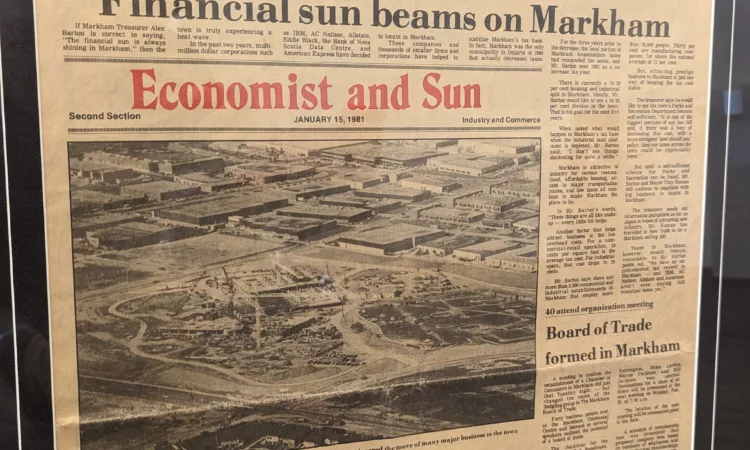Deep connections to complex, foundational technology
Neighbouring jurisdictions Toronto and Kitchener-Waterloo boast some of the most recognizable software-driven companies of the 21st century: Google, Meta, Amazon. Markham’s marquee names, like AMD and Qualcomm are less familiar to the public. Specializing in the innovation and design of complex, esoteric technologies, their products form the hardware substrate animating everything from smartphones to toasters to medical devices and automobiles.
It’s a relationship with complexity that goes back decades.
Like Silicon Valley, whose foundations were laid in the early development and refinement of integrated circuits and semiconductors, Markham’s history was shaped by its own experiments with those foundational devices that built the digital age. But unlike California’s drama-soaked Silicon Valley founding story of the Traitorous Eight, Shockley Semiconductor, Fairchild and the “Fairchildren”, there were no research institutions – no Stanford, no Berkeley, no Caltech, no Xerox PARC – powering Markham’s genesis. What brought sophisticated tech giants like AMD and Qualcomm to Markham was an innovative private sector pioneering cutting-edge products that tapped into emerging commercial opportunities.
By the 1970s, local successes like ITL Circuits and GEAC Computer Corporation had made Markham part of the global tech scene. Founded in 1971, ITL Circuits became one of North America’s leading providers of printed circuit board [PCB] fabrication services, GEAC, meanwhile, became a top global supplier of mission critical Enterprise Resource Planning [ERP] software and services. In the words of Zbigniew Stachniak, Associate Professor, Department of Electrical Engineering and Computer Science and founder of the Computer Science Museum at York University, GEAC “owned the world”.
By the 1980s, Markham had developed an international reputation as a tech centre. Its printed circuit board [PCB] community, led by ITL Circuits and Microart, was reputed to be the world’s second largest after Silicon Valley. In 1983, IBM made a surprise move from Toronto to Markham. Ably abetted by the strategic insights and interventions of its municipal government, it was, at the time, one of the world’s most important tech companies. Simultaneously, its semiconductor sector blossomed – starting with Array Technology Inc. [ATI].
Founded in 1985 by Kwok Yuan Ho, Lee Lau and Benny Lau, ATI became one of the world’s largest makers of computer graphic chips and boards. Its cutting edge graphics processors found their way into cell phones, TV set-top boxes and the Nintendo GameCube gaming console. By 1999, ATI was the world’s largest chipmaker. Acquired in 2006 by Santa Clara-based AMD, one of the “Fairchildren” the deal was, at the time, the largest acquisition in the PC industry.
Semiconductor technology continued to be a fertile sector for Markham. Genesis Microchip, founded in 1987, designed and produced display controllers – integrated circuits that receive and process analog and digital videos and graphics for flat-panel displays. The early successes of ATI and Genesis were followed by those of Jaldi Semiconductor [semiconductors for digital video equipment], ViXS Systems, [revolutionary media processing semiconductor solutions for video over IP and streaming] and Fresco Microchip [a leader in RF analog and digital semiconductors].
